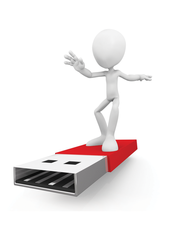Knoppix 7.3 CeBIT Edition
Go Live!

© Lead Image © Michael Novelo, 123RF.com
Knoppix 7.3 comprises the current state of Debian GNU/Linux development and comes with the current hardware support of kernel 3.13, a new update function, and extended security and privacy features.
Keeping a distro current with GNU/Linux development can be quite difficult. Debian's boot system and hardware support via udev can make it difficult for the developer of a Linux distribution to figure out what needs to change just to boot up. Lucky for me, Knoppix's boot system again proved to be a big timesaver. Knoppix completely works around the Debian default startup systems (Upstart/systemd) by using knoppix-autoconfig, a single shell script that does all the work of preconfiguration (Figures 1 and 2). Kernel support for devtmpfs had to be enabled to get the new udev hardware detection and removable device support working again, but the rest of the transition to the Debian testing branch (pre-jessie) went pretty smoothly.
Knoppix on Flash – Now with Update
Many modern netbooks and ultrabooks do not even have a DVD drive anymore, so Knoppix is commonly used on a USB flash disk instead of a DVD. Because creating a bootable USB flash disk is probably the first thing you want to do, Knoppix 7.3 now prominently shows an icon for the Knoppix flash disk installation program at the top left of the desktop when booting from DVD (Figures 3 and 4). Even though the Knoppix DVD version is read-optimized by a sort list, which tries to reduce the slow seek speed of the laser read sensor, flash memory boosts startup and the working speed of Knoppix by a factor of at least five. Startup time from loading the kernel to a full desktop with Compiz takes less than 15 seconds if you have recent computer hardware and fast flash pen drives.
One of the features most asked for last year was the ability to upgrade. Flash-knoppix, the Knoppix flash disk installation program, now scans the target drive for an existing Knoppix installation (Figure 5) and offers to replace just the main compressed filesystem and kernel, instead of installing everything from scratch.
[...]
Buy this article as PDF
(incl. VAT)
Buy Linux Magazine
Subscribe to our Linux Newsletters
Find Linux and Open Source Jobs
Subscribe to our ADMIN Newsletters
Support Our Work
Linux Magazine content is made possible with support from readers like you. Please consider contributing when you’ve found an article to be beneficial.

News
-
Another Linux Malware Discovered
Russian hackers use Hyper-V to hide malware within Linux virtual machines.
-
TUXEDO Computers Announces a New InfinityBook
TUXEDO Computers is at it again with a new InfinityBook that will meet your professional and gaming needs.
-
SUSE Dives into the Agentic AI Pool
SUSE becomes the first open source company to adopt agentic AI with SUSE Enterprise Linux 16.
-
Linux Now Runs Most Windows Games
The latest data shows that nearly 90 percent of Windows games can be played on Linux.
-
Fedora 43 Has Finally Landed
The Fedora Linux developers have announced their latest release, Fedora 43.
-
KDE Unleashes Plasma 6.5
The Plasma 6.5 desktop environment is now available with new features, improvements, and the usual bug fixes.
-
Xubuntu Site Possibly Hacked
It appears that the Xubuntu site was hacked and briefly served up a malicious ZIP file from its download page.
-
LMDE 7 Now Available
Linux Mint Debian Edition, version 7, has been officially released and is based on upstream Debian.
-
Linux Kernel 6.16 Reaches EOL
Linux kernel 6.16 has reached its end of life, which means you'll need to upgrade to the next stable release, Linux kernel 6.17.
-
Amazon Ditches Android for a Linux-Based OS
Amazon has migrated from Android to the Linux-based Vega OS for its Fire TV.

